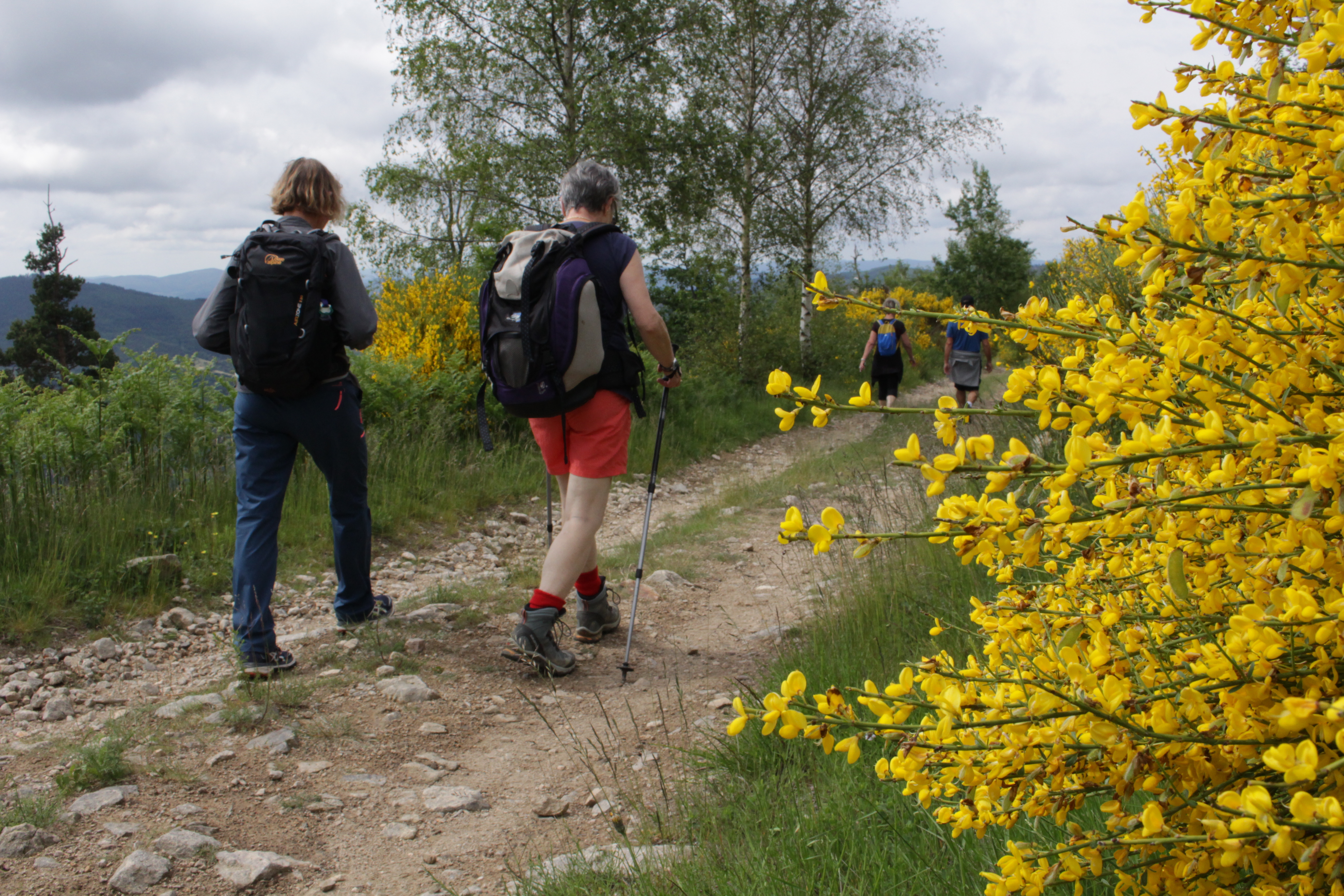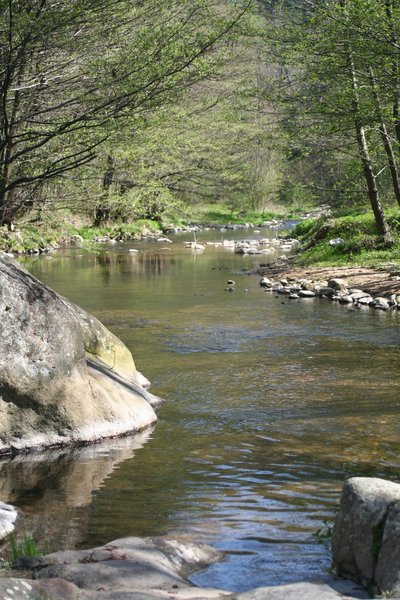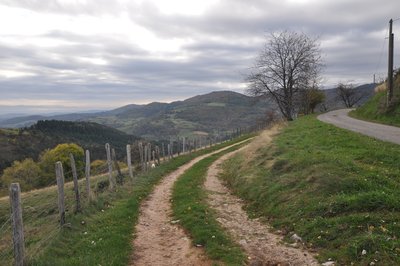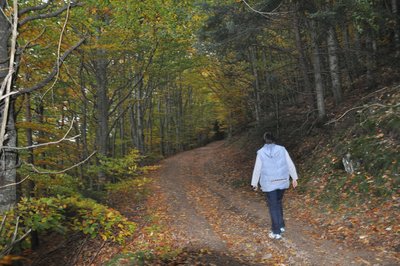
Pailharès
Easy
3h
10,5km
+495m
-493m
Embed this item to access it offline
5 points of interest

La Daronne en aval de Saint Félicien - Ardèche Hermitage Tourisme  Geology
GeologyThe Daronne river and its ?????
The village of Pailharès is situated on the higher part of the Daronne catchment area. The catchment area is the entire zone that collects water and directs it towards a river and its tributaries. It is a sort of bottleneck that swallows up all the streams coming into the river. It therefore has its own boundaries : divides that naturally follow the mountain ridges. Rainfall falling on one side of the slope accumulates, running into the streams that finally go into the river Daronne that then flows into the river Doux, a tributary of the river Rhône. This same rainfall may also filter into gaps in the rock forming groundwater then coming out in spring forms and feeding various streams. On site, these many streams can be seen thanks to the presence of a specific vegetation (particularly water absorbing plants) such as bullrushes, birch, easily noticeable with its white bark, alder and willow , only to mention a few.
Point de vue sur la vallée de la Daronne - Ardèche Hermitage Tourisme  Panorama
PanoramaViewing point
Splendid views of the Daronne Valley and the French Alps
Forêts de hêtres - Ardèche Hermitage Tourisme  Flora
FloraA short tale about Ardèche woodland today
At the beginning of the 20th century there was no more than 100,000 hectares of woodland in Ardèche. Many farmers were always searching for more land even on steep slopes (terraces). Following the two world wars and a huge rural exodus much of this land was abandoned. Some was transformed into woodland and other became wilderness or moorland. The forest now covers 250,000 hectares, almost a third of the size of Ardèche and is constantly gaining ground. The forest belongs to many private owners, many of them farmers. They own 90% of the total surface of woodland, however, the division of these forest areas causes complications for its management.. Flora
FloraAfter the fire
In 2003 a great fire destroyed a large part of the forest in le Serre des Vernes area. Around ten years later nature took over again and vegetation enabled the mountain to restore its colours. Here we explain the different stages of how nature came back to life :- the pioneering stage : moss and lichen appeared – the blooming stage : after a few years the grass and plant cover became more dense. – the bush and shrub stage : after the appearance of brambles and broom other bushes began to develop (blackthorn, hawthorn, dog rose…) to form a very dense “bushy moorland” – The woodland stage : It took at least 30 years (and even more) for well-established trees to grow naturally again ( hazelnut, oak, Sylvester pine…) It took even longer for the area of Serre des Vernes to see its forest again. Panorama
PanoramaViewing point
Viewing point
Description
Climb the small road for 50m going towards the Col du Marchand.
1 - Pailharès - 693m Follow Le Clos de Pierre Martin 2.1 km Col du Marchand 4.3 km
Follow the concrete lane becoming tarmac further on. Go past the house and into the forest of chestnut trees on a dirt track. After the river, head uphill coming out of the woods on a pretty stone-paved path leading you to a road. Turn left and go as far as the following house (Fontay) and take the grass path adjacent to it. The path leads to a road where you turn right.
2 - Le Clos de Pierre Martin - 739 m Follow Col du Marchand 2.2 km Lalouvesc 6.4 km
Follow the path edged with old poplar trees. Go through a chestnut grove until you get to a junction above some houses les Granges.
3 - Les Granges - Follow Col du Marchand 1.7 km Lalouvesc 5.9 km
Continue ahead on the main path. Pass a dell until you come to a fork 220m further on. Turn right downhill, jump over a small stream and bear left heading uphill on a windy path through thicket. This comes out onto a track that takes you up to the main road. Turn left and head for Col du Marchand.
4 - Col du Marchand - 903 m Follow Le Serre des Vernes 1.9 km Pailharès 5.7 km
A steep dirt track on the left will take you to a wider path further up. Turn left immediately where the path takes you to higher ground in the forest. When you reach a lane turn left. The lane then goes down towards Les Vernes.
5 - Le Serre des Vernes - 1080 m Follow Pailharès 3.8 km
Go along past la maison des Vernes, then a wide dell to a fork. Turn left downhill leaving the main path behind you a little further on, for a grassy path to your left. Cross the stream and continue ahead on a stone-paved path to the hamlet Baud. Go through, then down on a small lane in the shade. Further down take a path below the road that brings you back onto the same road further on. Go past the building Nectardechois and onto another road and finally continue ahead back to the village.
1 - Pailharès - 693m Follow Le Clos de Pierre Martin 2.1 km Col du Marchand 4.3 km
Follow the concrete lane becoming tarmac further on. Go past the house and into the forest of chestnut trees on a dirt track. After the river, head uphill coming out of the woods on a pretty stone-paved path leading you to a road. Turn left and go as far as the following house (Fontay) and take the grass path adjacent to it. The path leads to a road where you turn right.
2 - Le Clos de Pierre Martin - 739 m Follow Col du Marchand 2.2 km Lalouvesc 6.4 km
Follow the path edged with old poplar trees. Go through a chestnut grove until you get to a junction above some houses les Granges.
3 - Les Granges - Follow Col du Marchand 1.7 km Lalouvesc 5.9 km
Continue ahead on the main path. Pass a dell until you come to a fork 220m further on. Turn right downhill, jump over a small stream and bear left heading uphill on a windy path through thicket. This comes out onto a track that takes you up to the main road. Turn left and head for Col du Marchand.
4 - Col du Marchand - 903 m Follow Le Serre des Vernes 1.9 km Pailharès 5.7 km
A steep dirt track on the left will take you to a wider path further up. Turn left immediately where the path takes you to higher ground in the forest. When you reach a lane turn left. The lane then goes down towards Les Vernes.
5 - Le Serre des Vernes - 1080 m Follow Pailharès 3.8 km
Go along past la maison des Vernes, then a wide dell to a fork. Turn left downhill leaving the main path behind you a little further on, for a grassy path to your left. Cross the stream and continue ahead on a stone-paved path to the hamlet Baud. Go through, then down on a small lane in the shade. Further down take a path below the road that brings you back onto the same road further on. Go past the building Nectardechois and onto another road and finally continue ahead back to the village.
- Departure : Pailharès - village stopover area
- Arrival : Pailharès - village stopover area
- Towns crossed : Pailharès
Altimetric profile
Information desks
6, place du 8 mai 1945 - BP 70019, 26601 Tain l'Hermitage
Access and parking
Follow the D273 from Saint Félicien to Pailharès
Parking :
Village stopover area
Accessibility
- Accessibility level :
- Emergency number :
- 114
Report a problem or an error
If you have found an error on this page or if you have noticed any problems during your hike, please report them to us here:

